There are numerous ways to cut a diamond to create stunning jewelry pieces. However, some cuts have gained more popularity than others. Today, we’ll explore the radiant cut and the emerald cut, both of which have been favored by many for a long time. You may have even come across these cuts without knowing their names.
That’s why we’re here to provide you with detailed information about these two diamond cuts and highlight their differences, including price, shape, complexity of the cut, and more. We understand that this is a comprehensive subject, but we’re confident in our ability to provide you with all the answers you need to make a decision between these two diamond cuts.
Considering the wealth of information available on this topic, let’s dive right in and begin our exploration!
DESIGN YOUR OWN ENGAGEMENT RING: START WITH A SETTING OR START WITH A DIAMOND. IT’S REALLY UP TO YOU!
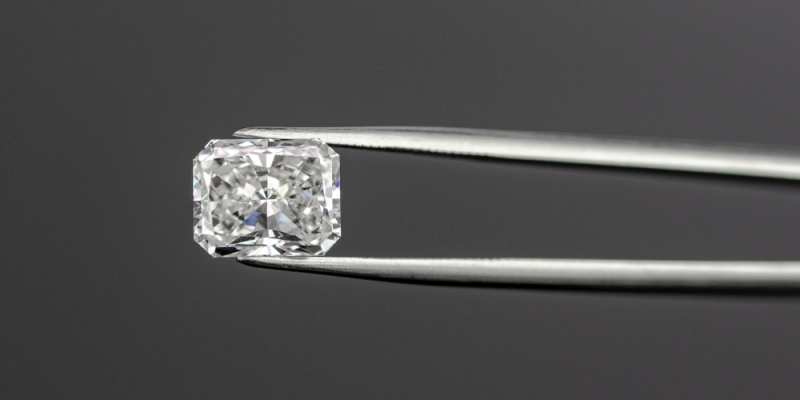
Radiant Cut
Square-shaped diamonds have maintained their popularity for many years, and among the various cuts that create this shape, the radiant cut stands out as one of the most recognized and contemporary styles.
Radiant cut diamonds, introduced in 1977, are commonly used in rings and earrings, so if you’ve come across them before, it’s likely in these types of jewelry pieces. Whether you prefer a more elongated or square gem, a radiant-cut diamond will add a distinctive touch to your engagement ring.
The appeal of the radiant cut lies in its shape, which combines elements of step-cuts like the emerald cut and the brilliance of round brilliant cuts. This cut is designed with precise symmetry in the facets to enhance its brilliance and fire.
From a technical standpoint, it is recommended to choose a color grade of H or higher for radiant cut diamonds, as this is the standard for most jewelry pieces. Additionally, this cut produces a durable diamond, which is particularly important for jewelry intended for daily wear.
While diamonds are generally known for their hardness, certain cuts can result in brittle stones that are prone to cracking under pressure. However, the radiant cut creates a resilient stone that is resistant to damage. This durability contributes to the popularity of radiant cut diamonds. However, it’s worth noting that endurance is not the only advantage of this cut.
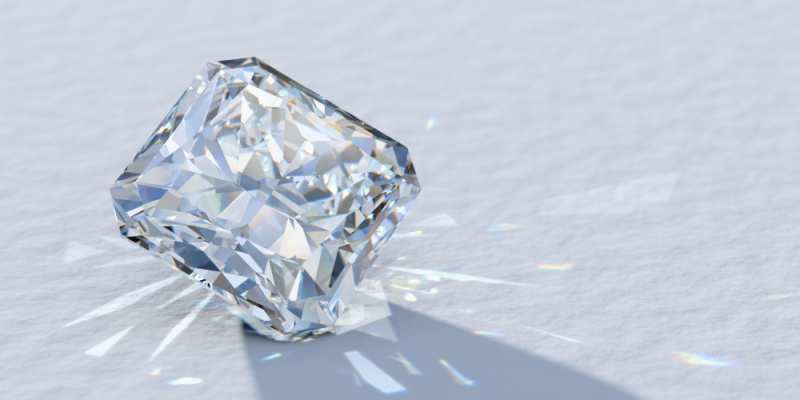
Visual Superiority
The radiant cut, developed by Henry Grossbard in New York in 1977, is a relatively newer diamond shape compared to the emerald cut, making it a modern choice for engagement ring designs.
With 70 facets, the radiant cut can have either a square or rectangular shape, depending on personal preference. The straight sides and slightly beveled corners enhance the stone’s strength and integrity.
The numerous facets of this diamond cut create a captivating “crushed ice” or kaleidoscope effect, adding extra sparkle to the stone. This effect helps to camouflage minor inclusions, enhance the diamond’s color, and visually amplify its apparent carat weight. As a result, radiant cut diamonds offer excellent value, making them suitable for couples on a budget.
During the 1980s, the radiant cut gained popularity due to its novelty. Today, it is frequently seen in vintage engagement rings, and it can also be reset into antique ring designs.
As mentioned earlier, radiant cut diamonds are commonly worn on specific occasions and in specific settings. They are particularly well-suited for earrings and rings, where they are most commonly found.
While you are free to wear your diamonds in any way you like, it is worth noting that earrings and rings with radiant-cut gemstones are often worn in semi-formal settings.
Price is always a significant factor in diamond discussions, as it is often a point of interest for many individuals. It comes as no surprise, as affordability plays a significant role for many buyers.
For a loose radiant cut diamond weighing 0.75 carats, prices typically range from $1500 to $2300, depending on factors such as clarity, color, location, and more.
It is important to consider that radiant cut diamonds are generally considered affordable, making them a popular choice for engagement rings. Earrings with radiant cut diamonds are also favored since the size of the diamonds embedded in earrings tends to be smaller, preventing prices from skyrocketing solely based on carat weight.
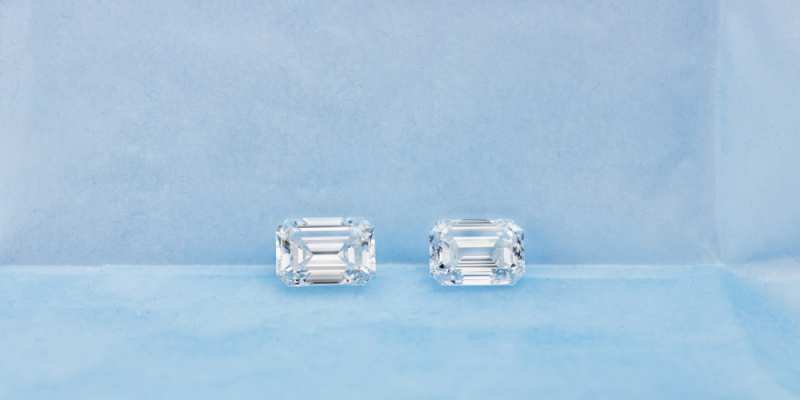
Emerald Cut
The emerald cut, with its history dating back approximately 500 years, is one of the oldest diamond cuts in existence, making it significantly more mature compared to the radiant cut.
During the early 1920s to the 1930s, the emerald cut gained popularity, and it was in the 1940s that it took on the modern form we recognize today through redesign.
The facets on emerald cuts are known as “step facets,” which categorizes them as part of the “step cut” family of diamonds. Step facets refer to the step-like arrangement of the facets, with three rows of steps above and below the stone. In total, the emerald cut features 57 facets.
The most common ratio for an emerald shape is 1:5, resulting in a rectangular stone, a recognizable characteristic it has maintained throughout its history. However, it’s worth noting that emerald cuts do not conceal imperfections well.
In terms of size, emerald-cut diamonds are commonly around 0.5 carats, making them 50% smaller than regular radiant cut diamonds.
Visual Preferences
Despite being found in some more expensive jewelry pieces, emerald cut diamonds have a relatively casual appearance, or as casual as diamonds can be. They can be seen frequently in daily life, both in jewelry stores and worn by individuals. If you spot an engagement ring, there’s a good chance the diamond atop it is an emerald-cut diamond.
People are drawn to emerald-cut diamonds for various reasons, but their elegant yet understated look is a significant appeal. They strike a balance between sophistication and simplicity.
Similar to radiant cut diamonds, emerald cuts also possess a square shape, making them easily identifiable. While both cuts are commonly found in square-shaped diamonds, when considering price, there is a higher chance of encountering an emerald-cut diamond.
Moreover, the emerald cut is widely available for purchase as it is a cut that diamond cutters frequently and easily execute. It has become a popular choice, and many people consider it a safe and timeless option.
The Price
The price of emerald-cut diamonds may come as a surprise. While precious stones often carry the assumption of being overpriced, that is not necessarily the case.
For a 0.5-carat diamond, the price range for an emerald cut falls between $850 and $1300. It’s important to consider that we are discussing a smaller diamond size.
In comparison, when discussing the price of radiant cut diamonds, we focused on diamonds weighing 0.75 carats, which are already 50% larger.
Both cuts have similar price ranges, but emerald-cut diamonds tend to be slightly smaller and more common. Consequently, the price is slightly lower compared to radiant cut diamonds.
It’s important to note that diamond prices can vary based on several factors, and the cut is just one aspect to consider. Nevertheless, having a rough idea of the cost for a diamond cut in this manner is valuable information.
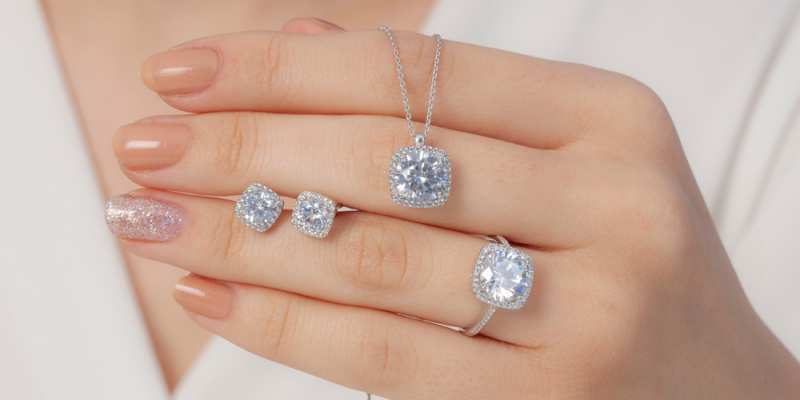
Which One Should You Pick?
We refrain from asserting that one cut is superior to the other as the choice of gem shape is a matter of personal preference.
Some individuals may favor radiant cut diamonds, while others may prefer emerald cut diamonds. However, this does not imply that one is inherently better than the other.
In essence, beauty is subjective, and it lies in the eyes of the beholder. Nonetheless, there are certain factors that differentiate the two cuts, such as price and availability, which we will delve into.
Firstly, it is evident that radiant cut diamonds tend to be slightly more expensive, but they often offer a slightly larger diamond size.
Let’s examine some of the key distinctions and similarities between these two cuts:
Facets: The radiant cut boasts 70 facets, whereas emerald cut diamonds feature 57 facets.
Clarity: Typically, an SI1 or SI2 clarity is recommended for radiant cut diamonds, whereas emerald cut diamonds often have a recommended clarity of VS2.
Color: For radiant cut diamonds, an H color or better is often recommended, while the G color is frequently suggested for emerald cut diamonds.
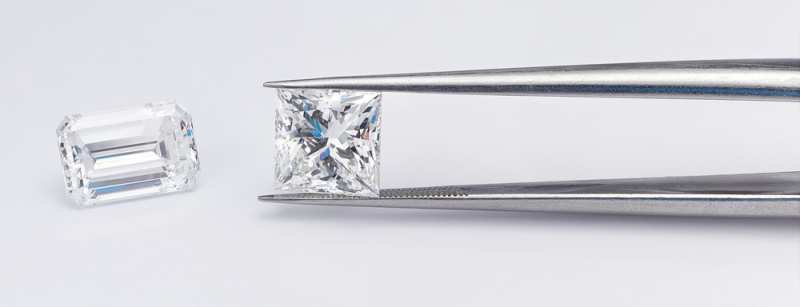
Our Final Thoughts
There is a lot to consider when discussing these two diamond cuts, isn’t there?
Both cuts feature a square shape and can be excellent choices for those on a budget. However, there are some differences between them. Let’s summarize them!
Firstly, there is a price difference, although not a significant one. Emerald cut diamonds are generally 50% smaller and more affordable, with options available for under $1000 if you search in the right places.
Secondly, we have observed differences in how people wear and perceive these diamonds. Radiant cut diamonds are often seen as more formal, while emerald-cut diamonds have a more casual appeal.
Additionally, the emerald cut has a longer history, making it more commonly seen compared to the radiant cut.
Ultimately, both cuts offer solid options, and we cannot definitively say that one is better than the other in the radiant cut vs. emerald cut diamonds debate. However, we can assure you that you won’t go wrong with either of them.


